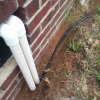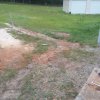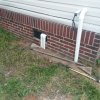I suddenly feel like I’ve not been very productive during quarantine.
Epoe trench 750ft long
- Thread starter Bryan
- Start date
You are using an out of date browser. It may not display this or other websites correctly.
You should upgrade or use an alternative browser.
You should upgrade or use an alternative browser.
tigerwillow1
Known around here
Yet another new term I had to look up. It was only a few years ago I was schooled on what a Pulaski is, and now I have Mattock in my knowledge bank. About the lightning risk: I've got about 3000' of buried cat6 running to 14 cameras in different locations. When I looked at the cost of ethernet surge protectors, the installation labor, and the added risk of failure from added connectors I made the choice to go without the surge protection. I consider the used POE switch I have to be expendable. It cost lest than a couple of surge protectors. I also considered the under-$100 cameras I started out with to be expendable. Now I'm slowly switching over to ~$150 cameras, increasing the risk. If I ever get a multi-hundred$ camera I may well spring for a surge protector on that one. Like so many other things there are tradeoffs and you try to make the best decision for what you're doing.I was using a mattock and a shovel.
tech101
Known around here
While we are talking about lightning risk and on that topic do we also do a ground for the PTZ cameras ? I have not done it .. But I am here in Bayarea where lightning risk is very very low. So I have never looked into it.. So is this something I should consider regardless or not worry about it since of the geographical location and low risk and my camera is mounted at 8-10 feet attached to the house cable runs to the poe switch and that is going into a UPS
Did you run any speed tests over that 1000ft run? just cuz it 'works' doesn't mean it will be full speed or reliable, but probably OK for a for single cam or two.
IPVM apparently did some testing of long cable runs here: IP Camera Long Distance Ethernet Test
but it's behind their paywall. Anyone with access care to share the jist of it?
IPVM apparently did some testing of long cable runs here: IP Camera Long Distance Ethernet Test
but it's behind their paywall. Anyone with access care to share the jist of it?
looney2ns
IPCT Contributor
Epoe has been around for a couple of years.
biggen
Known around here
- May 6, 2018
- 2,819
- 3,224
Did you run any speed tests over that 1000ft run? just cuz it 'works' doesn't mean it will be full speed or reliable, but probably OK for a for single cam or two.
IPVM apparently did some testing of long cable runs here: IP Camera Long Distance Ethernet Test
but it's behind their paywall. Anyone with access care to share the jist of it?
Dahua has a proprietary standard for what they call "ePoe". I think they certify something to like 10Mbps which is plenty for a single camera.
worst case, you could put something like this about halfway down the trench:
RB-EXTGE-101H Gigabit Ethernet Industrial Outdoor grade PoE 100m reach extender, cascadable, water-proof IP66
it's basically a PoE-powered 2-port ethernet switch, so would add a switch-worth of latency (and use some of the Poe budget, ~2w) in exchange for doubling range.
So that's an option to add later if the direct run doesn't pan out...
RB-EXTGE-101H Gigabit Ethernet Industrial Outdoor grade PoE 100m reach extender, cascadable, water-proof IP66
it's basically a PoE-powered 2-port ethernet switch, so would add a switch-worth of latency (and use some of the Poe budget, ~2w) in exchange for doubling range.
So that's an option to add later if the direct run doesn't pan out...
As an Amazon Associate IPCamTalk earns from qualifying purchases.
AP514
Getting comfortable
tigerwillow1
Known around here
I'm having a hard time understanding the questioning of the cable length or recommendation of extender devices. The thread is clearly labeled "Epoe trench". Simply looking up the epoe specs shows that a 750' cable should be easily handled and run at 100Mbps. I'd expect any devices inserted into the cable run to either do nothing or cause it to fail. This information is not difficult to find.

To read all of the gory details, try "epoe white paper" in a search engine. Here's one result:

To read all of the gory details, try "epoe white paper" in a search engine. Here's one result:
- Nov 25, 2016
- 265
- 274
Like I said, I tried it on a new roll of 1000 ft cable in my bedroom. See the previous pics. Very slight lag but quality was great..
You and me both. I thought i was doing good running a couple POE cables through my attic.I suddenly feel like I’ve not been very productive during quarantine.
@Bryan making us all look like slackers.
- Nov 25, 2016
- 265
- 274
Last year pic for my 62nd birthday..after the last 3 months stuck at home not as buff..just turned 63 a couple of weeks ago. Now if I could do something with the hound dog face..You and me both. I thought i was doing good running a couple POE cables through my attic.
@Bryan making us all look like slackers.
Attachments
- Nov 25, 2016
- 265
- 274
Happy belated birthday, and keeping active keeps you young. Good work on the trench!
shalem2014
Getting the hang of it
As long as all the electrical connections are well insulated and the camera chassis is isolated, the risk should be minimal. One could install a gigabit Ethernet surge suppressor to further mitigate the risk, although this could push the system just over the limit of what the long wire can do.Bryan, are you in an area that sees a lot of thunderstom activity? Even if it works relaibly, running an ethernat that far may well expose connected devices to serious charge potential and possible damage. other options would be fiber or a dedicated wireless link. you still need power, of course, but at least your switch/network would be isolated...
Shutting down the system is as good as doing nothing—it is the brief electrical difference in grounds at the local and remote locations that causes a common-mode surge that fries equipment and everything attached to it. If this problem exists, the only solutions are to:About the only protection I have is that I shut the system down every time a storm comes up. Could also unplug the Cat6 from the EPOE switch near the NVR when I shut the system down. Thanks..
- Eliminate the secondary ground connection that is introducing the stray voltage to the system. It could be as innocent as a metal camera with an internally grounded chassis, now wet, mounted on the side of a wet building, with a blade of grass going between earth and the side of the building that introduces the surge.
- Unplug any cables exiting the building and going any distance outside during stormy activity. Of course, if a storm crops up while you're away, or if you forget, this is as good as having no protection.
- Install a grounded Ethernet surge suppressor between the incoming cable and your equipment that shunts the voltage difference to your local ground. Make sure the Ethernet surge suppressor protects all eight leads and has a ground wire! There are cheap ones with no ground lead that only protect the four 100 Mb/s wires against differential surges, which are completely useless. I've seen these built-in to several Uninterruptible Power Supplies too, providing a false sense of security. They should be banned from the market!
Whatever you do, NEVER run an additional ground. This is where the surge is coming from—the difference between the ground potential at your building and the ground potential at the end of the cable. It is far better to leave the system floating and unprotected. Usually, the most that will happen is you'll have to reset your camera and switch as the powerful electrical noise causes the microprocessors to lose sync and lock up. Worst case scenario if it's a very close strike, you'll lose one or both devices as they both provide alternate paths to ground, protecting the rest of your network. Install a ground at the remote location without adding Ethernet surge protection? EVERYTHING connected to your system will likely be fried, first storm that comes by. Every camera, your switch, your NVR, every PC on your network, your Internet modem, your TV—anything that there is an Ethernet cable interconnecting.While we are talking about lightning risk and on that topic do we also do a ground for the PTZ cameras ? I have not done it .. But I am here in Bayarea where lightning risk is very very low. So I have never looked into it.. So is this something I should consider regardless or not worry about it since of the geographical location and low risk and my camera is mounted at 8-10 feet attached to the house cable runs to the poe switch and that is going into a UPS
- Nov 25, 2016
- 265
- 274
Something like this one with GDT?As long as all the electrical connections are well insulated and the camera chassis is isolated, the risk should be minimal. One could install a gigabit Ethernet surge suppressor to further mitigate the risk, although this could push the system just over the limit of what the long wire can do.
Shutting down the system is as good as doing nothing—it is the brief electrical difference in grounds at the local and remote locations that causes a common-mode surge that fries equipment and everything attached to it. If this problem exists, the only solutions are to:
- Eliminate the secondary ground connection that is introducing the stray voltage to the system. It could be as innocent as a metal camera with an internally grounded chassis, now wet, mounted on the side of a wet building, with a blade of grass going between earth and the side of the building that introduces the surge.
- Unplug any cables exiting the building and going any distance outside during stormy activity. Of course, if a storm crops up while you're away, or if you forget, this is as good as having no protection.
- Install a grounded Ethernet surge suppressor between the incoming cable and your equipment that shunts the voltage difference to your local ground. Make sure the Ethernet surge suppressor protects all eight leads and has a ground wire! There are cheap ones with no ground lead that only protect the four 100 Mb/s wires against differential surges, which are completely useless. I've seen these built-in to several Uninterruptible Power Supplies too, providing a false sense of security. They should be banned from the market!
Whatever you do, NEVER run an additional ground. This is where the surge is coming from—the difference between the ground potential at your building and the ground potential at the end of the cable. It is far better to leave the system floating and unprotected. Usually, the most that will happen is you'll have to reset your camera and switch as the powerful electrical noise causes the microprocessors to lose sync and lock up. Worst case scenario if it's a very close strike, you'll lose one or both devices as they both provide alternate paths to ground, protecting the rest of your network. Install a ground at the remote location without adding Ethernet surge protection? EVERYTHING connected to your system will likely be fried, first storm that comes by. Every camera, your switch, your NVR, every PC on your network, your Internet modem, your TV—anything that there is an Ethernet cable interconnecting.
As an Amazon Associate IPCamTalk earns from qualifying purchases.
- Nov 25, 2016
- 265
- 274
LConley
n3wb
I think I would run 10 AWG with ground and fiber, this would give me options.
- Nov 25, 2016
- 265
- 274
10 AWG, even 12AWG 1000ft rolls were too expensive for me. Since I only needed about 2-3 amps, opted for using a variable power adapter to get 12V at the end.I think I would run 10 AWG with ground and fiber, this would give me options.








